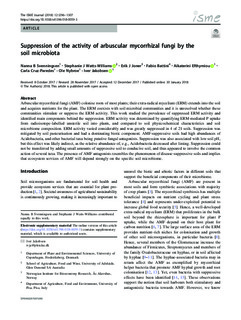| dc.contributor.author | Svenningsen, Nanna B. | |
| dc.contributor.author | Watts-Williams, Stephanie J | |
| dc.contributor.author | Joner, Erik | |
| dc.contributor.author | Battini, Fabio | |
| dc.contributor.author | Efthymiou, Aikaterini | |
| dc.contributor.author | Cruz-Paredes, Carla | |
| dc.contributor.author | Nybroe, Ole | |
| dc.contributor.author | Jakobsen, Iver | |
| dc.date.accessioned | 2018-11-20T11:55:55Z | |
| dc.date.available | 2018-11-20T11:55:55Z | |
| dc.date.created | 2018-01-31T21:14:22Z | |
| dc.date.issued | 2018-01-30 | |
| dc.identifier.citation | The ISME Journal. 2018, 12 (5), 1296-1307. | nb_NO |
| dc.identifier.issn | 1751-7362 | |
| dc.identifier.uri | http://hdl.handle.net/11250/2573969 | |
| dc.description.abstract | Arbuscular mycorrhizal fungi (AMF) colonise roots of most plants; their extra-radical mycelium (ERM) extends into the soil and acquires nutrients for the plant. The ERM coexists with soil microbial communities and it is unresolved whether these communities stimulate or suppress the ERM activity. This work studied the prevalence of suppressed ERM activity and identified main components behind the suppression. ERM activity was determined by quantifying ERM-mediated P uptake from radioisotope-labelled unsterile soil into plants, and compared to soil physicochemical characteristics and soil microbiome composition. ERM activity varied considerably and was greatly suppressed in 4 of 21 soils. Suppression was mitigated by soil pasteurisation and had a dominating biotic component. AMF-suppressive soils had high abundances of Acidobacteria, and other bacterial taxa being putative fungal antagonists. Suppression was also associated with low soil pH, but this effect was likely indirect, as the relative abundance of, e.g., Acidobacteria decreased after liming. Suppression could not be transferred by adding small amounts of suppressive soil to conducive soil, and thus appeared to involve the common action of several taxa. The presence of AMF antagonists resembles the phenomenon of disease-suppressive soils and implies that ecosystem services of AMF will depend strongly on the specific soil microbiome. | nb_NO |
| dc.language.iso | eng | nb_NO |
| dc.relation.uri | https://www.nature.com/articles/s41396-018-0059-3 | |
| dc.rights | Navngivelse 4.0 Internasjonal | * |
| dc.rights.uri | http://creativecommons.org/licenses/by/4.0/deed.no | * |
| dc.subject | Mycorrhiza | nb_NO |
| dc.title | Suppression of the activity of arbuscular mycorrhizal fungi by the soil microbiota | nb_NO |
| dc.type | Journal article | nb_NO |
| dc.type | Peer reviewed | nb_NO |
| dc.description.version | publishedVersion | nb_NO |
| dc.rights.holder | © The Author(s) 2018 | nb_NO |
| dc.subject.nsi | VDP::Matematikk og naturvitenskap: 400 | nb_NO |
| dc.subject.nsi | VDP::Mathematics and natural scienses: 400 | nb_NO |
| dc.source.pagenumber | 1296-1307 | nb_NO |
| dc.source.volume | 12 | nb_NO |
| dc.source.journal | The ISME Journal | nb_NO |
| dc.source.issue | 5 | nb_NO |
| dc.identifier.doi | 10.1038/s41396-018-0059-3 | |
| dc.identifier.cristin | 1559787 | |
| cristin.ispublished | true | |
| cristin.fulltext | original | |
| cristin.qualitycode | 2 | |

